“My mistake was that I have trusted people who did not deserve it.” Georges Lotfi, Lettre Ouverte, 2022
“I believe the Defendant thought he had laundered the antiquities so well and had created such good (albeit false) provenance that he did not think the ATU would be able to determine their true origin.” Affidavit accompanying warrant for Lotfi’s arrest authored by HSI Special Investigator Robert Mancene, August 3, 2022
The District Attorney of New York’s Antiquities Trafficking Unit (ATU), headed by Assistant DA Matthew Bogdanos, issued a warrant for the arrest of Lebanese art collector Georges Lotfi in August 2022. Lotfi is the primary suspect in a several-years-long investigation of Middle Eastern antiquities smuggling by the DANY’s ATU and Homeland Security Investigations (HSI). The warrant’s accompanying affidavit, written by HSI Special Investigator Robert Mancene, alleges that Lotfi illegally exported valuable ancient mosaics and a large Palmyran sculpture from the Lebanon and schemed to sell, gift and loan these and other antiquities to U.S. museums for his own profit.
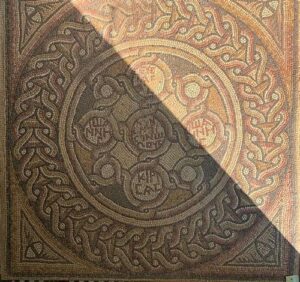
Greek church mosaic seized from Lotfi’s storage. courtesy District Attorney New York.
Lotfi, who is 81 years old, faces a mandatory minimum 1-3 year prison sentence and up to 25 years in state prison if convicted of the most serious felony charge of Possession of Stolen Property valued over $1,000,000; there are lesser charges on 23 other felony counts for antiquities of lower value. Lotfi, a retired pharmaceutical manufacturer as well as art dealer, is thought to be staying in Paris, where he has an apartment. According to the affidavit, Lotfi also has a home in Lebanon full of ancient art and another cache of Middle Eastern artifacts in Dubai.
One of the twists in this tale is that for several years, Lotfi has also been a key informant for the NY District Attorney.
Mancene writes in the affidavit:
“Over the years, the Defendant has provided me with detailed information about looting practices globally. Moreover, the Defendant and ADA Matthew Bogdanos, Chief of the ATU, have known each other for the better part of a decade, with the Defendant often serving as a valuable source of information on numerous antiquities-smuggling investigations.”
The District Attorney’s office acknowledges that it was Lotfi who tipped them off on its highest profile antiquities case, the Metropolitan Museum’s gold Egyptian sarcophagus. However, they assert that Lotfi attempted to curry favor with law enforcement by providing information as a means of ‘laundering’ his own stolen goods. The affidavit details contacts between Lotfi and ATU personnel and is replete with subjective analysis regarding Lotfi’s supposed motives and state of mind – an analysis based upon Lotfi’s shared confidences with the ATU based on his trust in Bogdanos and Mancene.
Another concerning factor is the age of the warrant’s criminal allegations against Lotfi – the facts about events that happened many decades ago are often impossible to verify:
Some of the alleged crimes involved:
- Six seized mosaics looted during the war in Syria in the 1970s and 1980s; Lotfi is said to have purchased them in Lebanon during the mid-1970’s to mid-80’s.
- Six Syrian mosaics purchased from Mohammad Al Haddad in Lebanon and shipped by Lotfi from Lebanon to NY in October 1988.
- Two Syrian mosaics purchased by Lotfi in Lebanon from dealer Farid Ziadé in June 1985; one shipped to Geneva in 1987 and one shipped to NY in 1988.
- Nine Lebanese mosaics purchased by Lotfi in Lebanon in the late 1970s to 1980s, shipped from Lebanon to Geneva in 1987 and NY in 1988.
- Four Lebanese mosaics purchased in Lebanon by Lotfi in the 1970s and 1980s and shipped from Beirut to Geneva in 1987.
- Five Lebanese mosaics purchased in Lebanon by Lotfi and shipped from Lebanon to NY in October 1988.
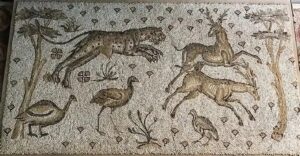
Mosaic seized from Lotfi’s storage. courtesy District Attorney New York.
Lotfi has replied in a dramatic public declaration of his innocence on the Web from his home in Paris. He says that his antiquities were purchased legally under Lebanese law and properly declared to Lebanese customs on export and to American customs on import. Lotfi claims that he has been assisting the DANY and Homeland Security for years to help them to track down suspect antiquities without any recompense – but has now been betrayed by so-called friends in the Manhattan District Attorney’s office. His “big mistake,” he says, was to trust Bogdanos and Mancene.
Lotfi’s webpage, in French and English, is illustrated with images of personal emails from Assistant DA Bogdanos, among them a message asking him to sign a document waiving any claim against the DANY or the US Department of Homeland Security for the antiquities seized from Lotfi’s Jersey City storage space and admitting that he, Lotfi, “unlawfully removed them to save them from harm arising out of political and military unrest in the Middle East.” In a photograph of an email said to be from Bogdanos on Lotfi’s website, Lotfi has highlighted the text,
“Sign it and be a savior. Refuse to sign and be nothing more than a common thief.”
Lotfi says the seizures were retributive:
“Recently I contacted the Lebanese consulate in New York announcing that I wanted to repatriate the archaeological pieces sheltered in the USA. On this Bogdanos became furious and found no better way to put pressure on me, than to issue a Warrant of Arrest against me and move the artifacts from my Warehouse in Jersey City to an unknown destination.”
Untangling the case’s complex narrative of charges and countercharges will require details still missing. The affidavit has more to say about Lotfi’s alleged past trafficking of looted artifacts and his statements to investigators regarding these, than it does about the theft or smuggling of the antiquities that he is charged with possessing.
The case is further complicated because of the amount of time that has passed since the suspect mosaics were unearthed and the chaos prevailing in Lebanon through that country’s 1975-1990 civil war. Lotfi’s narrative is a striking introduction to the chaotic Lebanon of the sixties, seventies, and eighties when he purchased the seized mosaics and sculptures – he says – from legal, licensed dealers. Lotfi’s webpage reproduces records he says support his claims that he legally collected and exported artifacts from Lebanon. While both the DANY affidavit and Lotfi’s publication are self-serving, together, they portray a complex relationship that flatters neither dealer nor District Attorney.

Sculpture of a man, his wife and children, thought to be from Palmyra, Syria. Seized from Lotfi’s storage. Courtesy Manhattan District Attorney’s Office.
In addition, the law of the period, dating back to 1933, shows the extent that Lebanon’s government permitted trading and export of antiquities. The Lebanese laws themselves raise questions regarding the DANY/HSI affidavit’s allegations that all art taken from Lebanon was ‘stolen.’ In another puzzling complication, a brief 1988 decree from the Ministry of Tourism forbidding export of antiquities and dramatically changing the rules was issued the same year that Lotfi’s mosaics were exported, and we do not know the actual date of publication in the official gazette on which it became effective or when Lotfi’s container of mosaics cleared customs. The DANY’s affidavit states repeatedly that Lotfi himself told Mancene that he had no permits for export, yet the shipping documents make clear that the goods were processed by Lebanese authorities and transported by legitimate international carriers, raising questions about what Lotfi and the DANY each mean by a ‘permit’ and how much Lebanese government practice actually followed the letter of the law.
Finally, the DANY’s allegations that Lotfi’s actions were duplicitous and based on his profit motive, and that he attempted to trick the investigators into ‘laundering’ his stolen artifacts, are somewhat undercut by Mancene’s statements about the detailed information Lotfi provided to the ATU about his own and others ‘criminal’ past actions. Even in the DANY affidavit, Lotfi appears less cunning than naïve, and apparently committed to preserving Lebanese antiquities, at least according to standards of his time, some 40-50 years ago.
Lotfi’s expectation that the DANY would pay one of his sources – not him – for information that triggered the DA’s case against the Metropolitan Museum’s golden sarcophagus also looks different when seen through the lens of Lebanese laws. In Lebanon, paying informants for information on antiquities was not only normalized, but based on a fixed percentage of the fines levied against violators and its government even offered ‘bonuses” to informants.
The sequence of events, the warrant and the affidavit
Lotfi was charged in August 2022 with twenty-four counts of criminal possession of stolen property. The warrant describes the stolen property as twenty-three ancient mosaics from Syria and Lebanon and a massive carved limestone sculpture from Palmyra, Syria of a man, his wife and children.
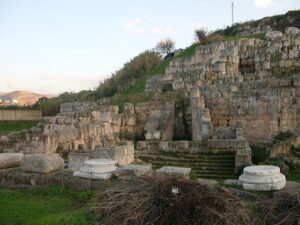
The site of Eshmun, Lebanon. The looting of the Temple of Eshmun was well documented. Eight sculptures from Eshmun were also discovered in Switzerland by Rolf Andreas Stucky, Director Swiss excavations, Swiss Foundation of Research, photo Odilia, CCA-SA 3.0 Unported license.
The affidavit was written by Homeland Security Special Investigator Robert Mancene, who is cross-designated as an investigator with the DANY as part of a joint task force working on a number of antiquities cases. It focuses a great deal on past DANY investigations in which Lotfi is said to have played a part. Lotfi is identified as the prior owner of a marble bull’s head seized from the Metropolitan Museum in 2017 valued at $12 million. The bull’s head was later shown to have been archaeologically excavated at Eshmun in 1967, and then stolen from Byblos by Christian militiamen in 1981 during Lebanon’s civil war.
Mancene argues that Lotfi’s extensive knowledge of the workings of the illegal trade makes it clear that he was a participant in illegal activities as well. The affidavit goes into detail regarding allegedly looted objects that have passed through Lotfi’s hands. An important mosaic purchased by the Met in the late 1990s, the Ktisis Mosaic, which was formerly owned by collector George Ortiz, is identified in the warrant as being purchased by Lotfi in Lebanon in the 1960s. This mosaic is presently in the Met but is not one of the seized items in the warrant. In the affidavit, Lotfi’s “detailed knowledge about an antiquity’s find spot” is taken as evidence that he knew for a fact that the mosaic, which he says he purchased in the 1960s, was looted.
However, his knowledge about the illegal trade is what made Lotfi a key source for law enforcement. Mancene acknowledges in the affidavit that Lotfi alerted the DANY to one of its most famous cases. Lotfi “first contacted ATU with information” about the golden sarcophagus of Egyptian high priest Nedjemank that was the centerpiece of a major exhibition at the Met, and which has since been returned to Egypt.
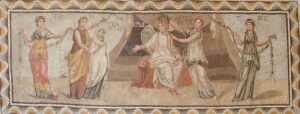
Lotfi Telete Mosaic, seized from Lotfi’s storage. Courtesy Manhattan District Attorney’s Office.
Mancene states that under New York State criminal law, an “owner” is defined as “any person who has a right to possession thereof superior to that of the taker.” Additionally, and unique to antiquities, whenever the country of origin has a clear pronouncement of patrimony i.e., a legal declaration of national ownership of all cultural heritage discovered after the enactment of that law then that country is the “owner.” (Lebanon does not have such a clear declaration of national ownership and even today, there are numerous private collections of antiquities, which owners are supposed to register.)
Mancene states that a thief can never acquire or pass good title, and that the time elapsed since a theft is irrelevant because criminal possession of stolen property is a “continuing crime” as long as the stolen object is possessed by anyone other than the legal owner:
“Thus, provided an antiquity has been possessed in New York County within the last five years and there is probable cause that the property is stolen, the ATU may seize such property and prosecute criminally culpable offenders. And we may do so regardless of the date of theft itself.”
In cases of undocumented antiquities, i.e., antiquities that were clandestinely looted from the ground, he says that NY law does not require direct evidence of the precise timing and location of a theft to prove an object constitutes stolen property, but relies, rather, on circumstantial evidence.
The affidavit includes indicators DANY considers “circumstantial evidence” of theft. While a photograph of an object taken at the site of an illegal excavation is clear evidence of wrongdoing, the affidavit also identifies an object having encrustations or having been submitted to the Art Loss Register as indicators of illegality and trying to create a false paper trail. (It can equally be argued that antique encrustation may stabilize an object and be useful for research and that taking the due diligence step of registering an object also puts objects on record for potential claimants.)
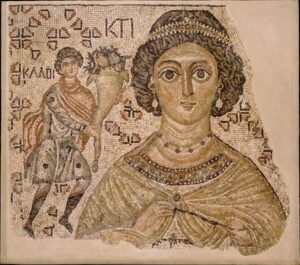
Ktisis Mosaic, in Metropolitan Museum, sold by Lotfi to the late collector Georges Ortiz and purchased in two sections by the Met in 1998-1999. Courtesy Metropolitan Museum of Art.
Lotfi did put a number of requests to the Art Loss Register for objects unrelated to the current seizure – with photos that remain in their files – but none of these antiquities appears to have ever been claimed by a source country using these records. (In fact, some major art fairs require submission of all antiquities to the Art Loss Register before they can be exhibited, as a form of vetting the objects.)
According to Mancene’s affidavit, “on September 20, 2018, the Defendant gave me a USB drive containing hundreds of photographs of looted and still-dirty (or in the process of being looted) ancient mosaics and statues.” Mancene says these photographs of objects in situ that Lotfi identified as “looted,” are “strikingly similar” in type to photographs found in a container of antiquities that Lotfi shipped from New York back to Lebanon in 2018. Then he states that, “collectively” the photos depict 6 of the 24 seized mosaics, implying that these too are looted.
The affidavit is also replete with subjective interpretations by Mancene of Lotfi’s thought processes. Lotfi invited Bogdanos and Mancene to view his collection of antiquities, seeking to have them cleared for future sales or donations and gave Mancene a key to his storage space. Mancene interprets this action negatively:
“The Defendant explained to me that he wanted to liquidate these antiquities, either by selling or by donating them to museums (including ones in New York County). Beginning in 2017, and continuing over the next three-and-a-half years, the Defendant made repeated requests to me, ADA Bogdanos, and other members of the ATU that we investigate his antiquities so that he could dispose of them. On November 10, 2017, he signed a Consent to Search form and gave me a key to Unit 458 of Extra Space Storage, telling me that the storage locker was his and that he was the owner of all its contents. Based on my conversations with the Defendant over the last several years, I believe the Defendant thought he had laundered the antiquities so well and had created such good (albeit false) provenance that he did not think the ATU would be able to determine their true origin. Furthermore, I believe that the Defendant thought he could use his relationship with me and with ADA Bogdanos to try to convince us that his false provenance was accurate and truthful. In his mind, any investigation by the ATU that did not result in the seizure of the antiquities would permit him to sell or donate (for tax benefits) these otherwise unsalable items.”
On February 24, 2021, Mancene, ATU members, an expert in Middle Eastern artifacts and US Customs and Border Protection officers went to Lotfi’s storage space in Jersey City, NJ and photographed and analyzed the 22 mosaics it contained. Lotfi told Mancene he had a Syrian mosaic and a stone funerary relief from Palmyra in another NJ storage space.
Five months later, the ATU applied for search warrants and seized all 24 objects.
The case against Lotfi for the possession of stolen property is strengthened by information from the ATU’s anonymous informants that 14 of the seized mosaics were from Syria, which has a 1963 law vesting ownership of antiquities in the State, giving rise to a national ownership claim that they are stolen from the State. Mancene also claims that it is illegal to export antiquities from another country from Lebanon. Lebanese law does require a permit for export, which Mancene states Lotfi is unable to supply. Mancene adds that Lotfi told him he exported four mosaics from Lebanon in July 1987 and another five in October 1988.
Although Lotfi provided bills of lading to Mancene for shipping “the Telete Mosaic from Lebanon to New York via Geneva on September 28, 1987, and the Iphigenia and Orestes Mosaic from Lebanon directly to New York on October 24, 1988,” Mancene says “there are no photographs depicting what mosaics were actually included in the container” and anyway, their shipment “violated both Syrian and Lebanese law.” Similarly, shipping invoices provided by Lotfi showed “11 crates of mosaics” shipped from Beirut to Geneva in July 1987, but Mancene says again that Lotfi told him he had no export permit.
The affidavit states, in effect, that regardless of the paperwork showing the official export of the mosaics, the fact that Lebanon’s government appears to have ignored the public sale of such objects by licensed dealers, and that it allowed their documented export without issuing the proper form of permit – – therefore, Lotfi knowingly possessed stolen goods for sale for his own profit in the State of New York. Mr. Mancene wrote:
“He has demonstrated not only his intimate knowledge of the illegal trade in antiquities from the Middle East and North Africa”… “but also his acute awareness of the hallmarks of looted antiquities from his extended involvement in buying, selling, or otherwise dealing in antiquities — thereby revealing to me his awareness of the stolen nature of his own antiquities.”
Was the 81 year old Lotfi truly as devious as the affidavit claims? Or did he have some justification for believing that his collection would pass legal scrutiny?
Lotfi’s Open Letter to the Public

Screenshot of Georges Lotfi’s Lettre Ouvert. https://georgeslotfi.fr/
Lotfi has issued a seven-page Open Letter on the Web, making a public claim that he was tricked and betrayed by Bogdanos and Homeland Security investigators in giving them information and carte blanche to access his collections. Lotfi’s narrative focuses first on his personal history. Born with “a more acute virus than Covid 19, ‘collectionitis’,” he began to gather antique objects in the 1960s while pursuing his pharmaceutical manufactures. Lotfi insists that his collecting was legal under Lebanese law and that as a private person, he has legal rights of ownership of his antiquities.
Lotfi acknowledges that he owned the multi-million dollar marble bull’s head described in the affidavit – and says that he sold it decades ago for $3500 to Frieda Tchacos’ Nefer Gallery in Switzerland. He describes other acquisitions and dealings with various dealers in Lebanon, while insisting that he purchased the mosaics and the statue for which he is charged with criminal possession in New York from licensed dealers in Lebanon who registered their inventory with its Cultural Ministry.
The webpage has images of the golden sarcophagus when it was offered to and refused by Lotfi, photocopies of Arabic documents from Lebanon’s Ministry of Culture, documents and bills of lading. It also includes marked-up copies of alleged email correspondence with Matthew Bogdanos and Robert Mancene.
Lotfi insists that he was trying to safeguard Lebanese artworks during its civil war period and through his role in assisting the DANY in the recovery of illicitly trafficked objects. Lotfi says that his intentions in having Bogdanos and DANY ‘vet’ his collection were legitimate:
“My target was to lend the 24 pieces to various American museums in order to exhibit them temporarily, following a routine classic judicial and administrative procedure. For this I have requested the approval of the American judicial authorities, asking them to inspect these objects in the New Jersey warehouse. And it is then that I see the same US authorities arbitrarily seize the 24 exhibits in July 2021, followed by an indictment and a US arrest warrant against me in August 2022, and between the two dates: threats received from the US prosecutor Bogdanos on July 23, 2022.”
The ‘paid informant’ issue

Screenshot of Georges Lotfi’s Lettre Ouvert. https://georgeslotfi.fr/
Lotfi maintains that he worked with Bogdanos and Mancene in order to help stop illegal trading, not for self-interest. The affidavit mentions that Lotfi asked for funds, but it appears that he did so on behalf of the informant on the gold sarcophagus. In the excerpts from emails between April and May 2018, published by Lotfi, and in which Lotfi repeatedly states that he is not looking for payment for himself, Bogdanos summarizes:
“1. Your friend will not help unless he is paid.
2. He is eligible to be paid only AFTER the information proves accurate AND we are able to act on it. Those are the rules.”
And
“As for your friend, I have repeatedly told you that there are NO risks whatsoever. Zero. Everything he says to me is completely confidential.”
An email from Mancene also attempts to clarify the “lengthy and intrusive” legal process for signing up paid informants.
Lotfi’s epistle not only sets forth his somewhat chaotic response to the various charges against him, but also expresses his personal outrage against Bogdanos and Mancene for what he describes as their arrogance and lack of respect. He says he will fight the charges not through lawyers but in this public forum. Lotfi writes:
“This is my story: I leave the public alone judge of this incredible saga, and someone should stop these gentlemen of the ATU.”
Lebanon’s laws
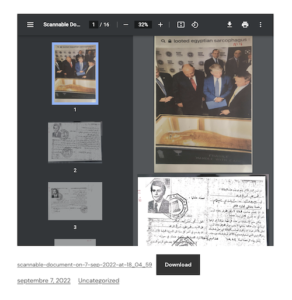
Screenshot of Georges Lotfi’s Lettre Ouvert. https://georgeslotfi.fr/
Finally, a look at Lebanon’s antiquities laws argues caution in making assumptions about whether an artifact was legally sold and exported. Before rendering judgement, more should be known about how Lebanon’s Ministry of Culture operated during the civil war years and how it supervised the country’s licensed (and unlicensed) antiquities traders. Unfortunately, thirty-five to fifty years later, the facts may not be discoverable.
The 30 Novembre 1933 Reglement Sur les Antiquités
Lebanon’s first antiquities law, the 30 Novembre 1933 Reglement Sur les Antiquités superseded a slew of Ottoman Turkish regulations. It was fully in force for half a century, then modified in part in 1988.
It provides under its General Provisions in Chapter I that the sale of even immovable antiquities (i.e. monuments) belonging to private individuals is permitted if owners comply with the provisions of this regulation and they have been registered in the General Inventory or given classified status (art. 74) Movable antiquities may be sold at auction by court order or when an estate is sold (art. 76) Even State owned movable objects may be sold if they are of “no interest whatsoever for its own collections” (art. 77).
Chapter II on the trade authorizes antiquities dealers to sell movable antiquities and to have rights of ownership over them if these objects are declared and presented to the Antiquities Department within 3 days by the dealer. This gives the State the opportunity to buy them, after which they are recorded in the dealer’s register if the seller and the buyer are acting in good faith, and the objects clearly do not come from illicit excavations (art. 79). No one may trade in antiquities without first receiving a written permit authorizing him to do so from the Director of Antiquities, and paying an annual levy of 25 L.L.S. (Lebanese-Syrian Pounds) (art. 81) A dealer may only trade in antiquities at a single shop (art. 83). Any merchant holding a permit to trade in antiquities must maintain a register of a type approved by the Antiquities Department in which he keeps a methodical inventory and complete description of the antiquities in his possession (art. 88). The register must include 1) a serial number, which must also be marked on the object itself, 2) description (size, composition, color, shape, design, condition) and place of origin of the object, 3) date of acquisition and notification number if one accompanies the object, 4) the name, occupation and address of the seller. When the object is sold, the sale must be entered in the register, along with the name, occupation and address of the buyer (art. 89). Any merchant authorized to trade in antiquities must post an official sign containing excerpts from the decree on antiquities relating to the ownership, trade in and export of antiquities, make available to buyers the full text of this decree, and must inform any buyer that a permit issued by the Director of the Antiquities Department is required to export ancient objects (art. 94).
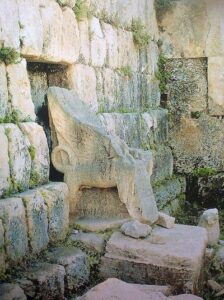
‘Astarte’s throne’ at the Eshmun temple, Bostan El Sheikh, near Sidon, Lebanon. Photo by Eli+, public domain, Wikimedia Commons.
Chapter V. of the 1933 law, On Exporting Antiquities notes that a permit is required and that in the case of exceptionally heavy or numerous antiquities, an inspection for export may be carried out on a dealer’s premises (Art. 94) There are no export taxes for scientific exports and items exported under partage arrangements (Art. 103) The State has a first right to purchase antiquities for the declared value when an export permit is requested (Art. 104)
If the Director of the Antiquities Department or the Curator of the National Museum “does not exercise this right to purchase the antiquities, the export permit may not be refused after payment by the applicant of a levy for delivery of the export permit for the ancient objects that is proportional to the value that he has assigned to the object in his declaration.
- This fee is set at:
- 5% for a value less than 50 L.S. (Syrian Pounds)
- 10% for a value of 501 to 1,500 L.S. (Syrian Pounds)
- 15% for a value of 1,501 to 2,500 L.S. (Syrian Pounds)
- 20% for a value of 2,501 and above.”
Under Art. 105, “Once these formalities have been completed, the beneficiary shall receive a permit, which he must present whenever requested by the agents specified in article 108 of this decree.” Art. 106 applies the same criteria to objects “sent abroad by mail.”
“Once the crate has been sealed with a wax or metal seal by the Antiquities Department, and after a stamped transit pass has been detached from a book of receipt stubs, signed and affixed by the representative of said Department, the crate shall be released to the shipper.”
Art. 107 covers penalties for export without a permit: “Anyone exporting or attempting to export movable antiquities without a permit shall be punished by a fine of 50 to 500 L.S. (Syrian Pounds). In addition, the ancient objects shall be confiscated and forfeited to the National Museums.”
Lebanon’s legal standards for paying informants
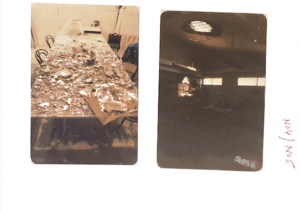
Broken mosaic on table. Screenshot from Georges Lotfi’s Lettre Ouvert. https://georgeslotfi.fr/
Interestingly, under the 1933 law (and perhaps even today in Lebanon, since the 1933 law was never repealed, only supplemented) informants who reported violations of antiquities laws were paid at a legally established rate of 25% of the fines levied – with finders bonuses:
A 1934 appendix to the 1933 law declared in Art. 1 that
“For each fine levied in accordance with the provisions of Decree No. 166/LR setting forth the regulations governing antiquities, 50% of the amount collected shall be allocated as follows: 25% to the informants, 25% to the agents confirming the violation, in accordance with article 108 of this document. In the absence of informants, the agents shall receive 50% of the fine levied.”
Under Art. 2, “If an ancient object has been seized and forfeited to the State, the “finder’s bonus”, in cash or in kind, shall be determined …and allocated to the informants and agents making the seizure. The appendix also gives the Director of the Antiquities Department or the Curator of the National Museum discretion based upon the combined amounts for agents and informants and the difficulty of proving the seizure or the violation, to pay or not pay the finder’s bonus on top of their share of the fine. (Art. 5)
Lebanon’s 1988 Ministry of Tourism Decree
Legal export of antiquities with permission and payment appears to have been possible under the 1933 law until issuance of a February 2, 1988 Decree No. 8, which stated in its entirety that:
One: The export of movable antiquities outside of Lebanese territory by any means is prohibited.
Two: Requests the Director General of Antiquities to cease granting licenses for the export of movable antiquities outside of Lebanon.
Three: Article three brought the decree into force on publication in the Official Gazette.[1]
This decree is dated to the same year as the Bill of Lading in which Lotfi states the last of the mosaics were shipped. The decree is 8 months earlier than the Bill of Lading. However, neither the date of clearance of the mosaics by the Lebanese authorities, nor the date of official publication is presently available.
Lebanon’s 2008 Cultural Property Law
Modern cultural property law was first enacted under Lebanon’s Law No. 37 Cultural Property on October 16, 2008.
The 2008 law broadens the definition of cultural property to encompass archeological, historical, or scientific locations or sites, products of archeological excavation and digging and any structures, landmarks, edifices, buildings, or part thereof, Objects having anthropological or ethnological significance, property pertaining to history, the life of peoples; the life of national leaders, intellectuals, scholars, and artists; and significant national events, every form of artistic work from paintings to films, photographs, and musical compositions, significant coins, medals, postal and financial stamps, manuscripts, books and archival documents, and rare geological, botanical, and biological specimens.
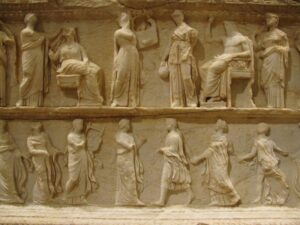
Eshmun, Assembly of Gods, Photo by Steven Damron, San Francisco, 2009, CCA 2.0 Generic license.
Cultural property of recognized or classified type may be privately or publicly owned. The law directs the Ministry to document cultural property that merits registration, whose preservation is a matter of public interest, on a List of Recognized Cultural Property or the List of Categorized Cultural Property, or General Antiquities Inventory, identifying the property owner or trustee (waqfs, organizations etc. as well as ministries may be deemed trustees). (Art. 4-11)
Cultural properties are not allowed to be transferred outside Lebanon except by a special authorization provided by the Minister of Culture; within Lebanon, they are not allowed to be transferred to the government of another state, to a non-Lebanese national, or a legal entity whose head office is not in Lebanon. (Art. 12)
However, even the 2008 law does not nationalize cultural property. The Ministry of Culture can exercise a right of preemption of property being transferred on payment of the sales price (Art. 13) and may take legal action to force the owner of a property at risk to properly care for and preserve it (Art. 14).
Interestingly, while cultural property belonging to another nation cannot be imported into Lebanon; it will be returned to that state “if the claiming state pays a fair compensation to the purchaser in good faith or owner with a valid deed, plus all expenses of shipping it back” (Art. 17-18).
In other respects, Articles 22 and 24 of the 2008 Law No. 37 left in place the 1933 law 166, unless the 1933 provisions “were incompatible” with the 2008 law.
Conclusion
In this story, what an enthusiastic prosecutor views as a clear-cut series of crimes is seen by the alleged perpetrator as working within the existing law to preserve objects at risk – as well as to profit legitimately by them. These conflicting narratives may contain truths on both sides. Certainly, both will be viewed with a certain skepticism – especially by persons familiar with Lebanon’s questionable history of archaeological management. We should proceed with caution and look to further developments.
[1] Decree No. 8 Regarding the Prohibition of the Export of Antiquities, Beirut, February 2, 1988. Source: translation from IFAR, International Foundation for Art Research, last visited September 11, 2022.
 Iphigenia & Orestes Mosaic, originally from Syria, courtesy District Attorney New York.
Iphigenia & Orestes Mosaic, originally from Syria, courtesy District Attorney New York. 

